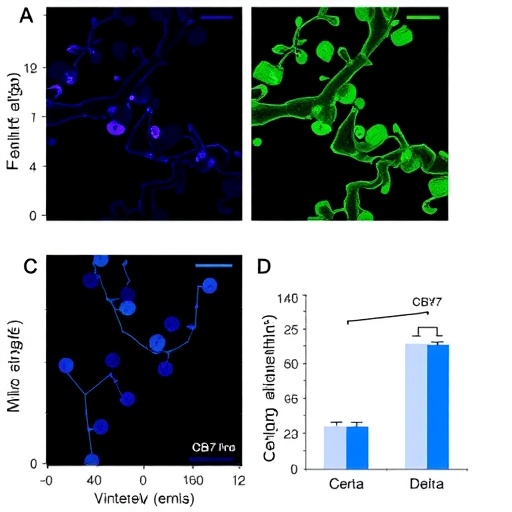In a groundbreaking advance for neonatal care, a recent study published in the Journal of Perinatology unveils compelling evidence on the efficacy of nasal intermittent positive pressure ventilation (NIPPV) in managing neonates suffering from grade 3 bronchopulmonary dysplasia (BPD). This severe form of BPD has long challenged neonatologists due to its complex pathophysiology and high morbidity rates. The clinical implications of these findings could reshape future respiratory support strategies for the most vulnerable infants, offering new hope in reducing the adverse outcomes associated with chronic lung disease of prematurity.
Bronchopulmonary dysplasia remains a formidable hurdle in neonatology, primarily affecting preterm infants who require prolonged respiratory support. It is characterized by arrested lung development and significant inflammation, leading to long-term respiratory complications and extended hospital stays. Grade 3 BPD represents the most severe manifestation, often necessitating invasive respiratory interventions with associated risks such as ventilator-induced lung injury and infection. The quest for non-invasive yet effective respiratory support modalities forms the cornerstone of improving neonatal lung outcomes, making this study’s insights particularly timely.
Nasal intermittent positive pressure ventilation, or NIPPV, is a non-invasive ventilatory modality that delivers breaths through nasal prongs, providing synchronized positive airway pressure. Unlike continuous positive airway pressure (CPAP), NIPPV incorporates intermittent pressure boosts, which can enhance alveolar recruitment and improve gas exchange. This method has grown in popularity due to its potential to reduce the duration of invasive ventilation and minimize lung trauma. However, its role in the subset of neonates with severe BPD, especially those categorized as grade 3, has remained under-investigated until now.
The authors, led by Weems and colleagues, conducted an extensive cohort study assessing the respiratory outcomes of neonates with grade 3 BPD supported with nasal intermittent positive pressure ventilation as opposed to conventional ventilation strategies. Their work involved meticulous monitoring of oxygen requirements, ventilator dependence, and markers of pulmonary function over an extended follow-up period. The study’s design allowed for a comprehensive evaluation of how NIPPV impacts the progression of lung disease severity and infants’ overall respiratory trajectory.
Intriguingly, the findings revealed that neonates managed with NIPPV demonstrated statistically significant improvements in oxygenation parameters and a reduced need for invasive mechanical ventilation. This is particularly notable because invasive ventilation is known to exacerbate lung injury through mechanisms such as volutrauma and biotrauma. By mitigating these risks, NIPPV not only stabilizes oxygen delivery but may also contribute to a more favorable pulmonary microenvironment that promotes healing and lung growth.
Delving deeper into the physiological mechanisms, the study highlights how intermittent positive pressure ventilation through the nasal route can facilitate enhanced alveolar inflation and reduce atelectasis, which is a common pathological feature in severe BPD. The respiratory support provided mimics natural breathing patterns more closely than constant pressure systems, potentially decreasing the work of breathing and energy expenditure in these fragile infants. This physiological mimicry might be critical in allowing premature lungs to sustain better gas exchange while avoiding further damage.
Moreover, the study underscores the importance of synchronizing ventilatory support with the neonate’s spontaneous respiratory efforts, a feature inherent to advanced NIPPV devices. This synchronicity minimizes patient-ventilator asynchrony, which often contributes to respiratory distress and prolonged ventilation duration. By aligning ventilatory assistance with the infant’s inherent breathing rhythm, NIPPV appears to ease the transition from mechanical support to eventual respiratory independence.
Another remarkable aspect of the investigation was its attention to the safety profile of NIPPV in this high-risk population. Whereas invasive ventilation carries risks of ventilator-associated pneumonia and airway trauma, NIPPV’s non-invasive approach significantly lowers these hazards. The study reported a reduced incidence of such complications, thereby reinforcing the viability of NIPPV as a first-line respiratory strategy in severe BPD cases. This finding holds enormous potential for improving quality of life and reducing healthcare burdens.
Equally important, the longitudinal data indicated that infants supported by NIPPV had shorter durations of hospitalization and faster weaning from supplemental oxygen compared to those receiving conventional ventilation therapies. These benefits translate into meaningful clinical advantages, including decreased exposure to hospital-associated infections and better neurodevelopmental outcomes by facilitating earlier home discharge and parental bonding.
The research team also explored the technical nuances associated with NIPPV, such as optimal pressure settings and equipment selection, to maximize therapeutic benefit. The careful titration of inspiratory pressures and synchronization parameters proved crucial to individualizing therapy, highlighting that NIPPV is not a one-size-fits-all intervention but rather a customizable approach tailored to the infant’s respiratory status and tolerance.
Importantly, this study raises compelling questions about the potential for integrating NIPPV into standardized treatment algorithms for neonatal BPD management. Given the promising outcomes noted, integrating NIPPV early in the treatment course for neonates at risk of developing severe lung disease could forestall progression and reduce cumulative lung injury. This proactive approach could revolutionize neonatal intensive care unit protocols worldwide.
Looking forward, the authors advocate for larger multicentric randomized controlled trials to validate their findings and refine patient selection criteria. Such efforts would be critical in establishing robust evidence-based guidelines and ensuring broad adoption of NIPPV. Furthermore, exploration into combining NIPPV with adjunctive therapies, such as pharmacological agents targeting pulmonary inflammation or stem cell therapy for lung regeneration, may amplify treatment efficacy.
The implications of these findings extend beyond the neonatal intensive care unit. Improved outcomes in severe BPD not only impact survival rates but also attenuate long-term respiratory morbidities in childhood and adulthood, including susceptibility to respiratory infections and chronic obstructive pulmonary disease-like sequelae. Thus, advancements in neonatal respiratory support have lifelong ramifications, underscoring the profound significance of optimizing therapeutic interventions such as NIPPV.
In summary, the work by Weems et al. marks a pivotal stride forward in neonatal respiratory medicine. Their elucidation of nasal intermittent positive pressure ventilation’s role in improving outcomes for infants with grade 3 bronchopulmonary dysplasia provides a beacon of hope for clinicians and families alike. The sophisticated balance of technological innovation and patient-specific care embodied by NIPPV exemplifies the future direction of neonatology—a future where precision respiratory support translates into healthier beginnings and better lifelong prognoses for our most delicate patients.
Subject of Research: Innovative respiratory support for neonates with severe bronchopulmonary dysplasia using nasal intermittent positive pressure ventilation.
Article Title: Nasal intermittent positive pressure ventilation in neonates with grade 3 bronchopulmonary dysplasia.
Article References:
Weems, M.F., Lamba, V., Chilakala, S. et al. Nasal intermittent positive pressure ventilation in neonates with grade 3 bronchopulmonary dysplasia. J Perinatol (2025). https://doi.org/10.1038/s41372-025-02472-1
Image Credits: AI Generated
DOI: 17 November 2025
Tags: bronchopulmonary dysplasia treatmentchronic lung disease in preterm infantsclinical implications of NIPPVgrade 3 BPD interventionsJournal of Perinatology findingsnasal intermittent positive pressure ventilationneonatal care advancementsneonatal lung disease managementneonatal respiratory support strategiesnon-invasive respiratory support for neonatesreducing morbidity in neonatesrespiratory complications in premature infants





